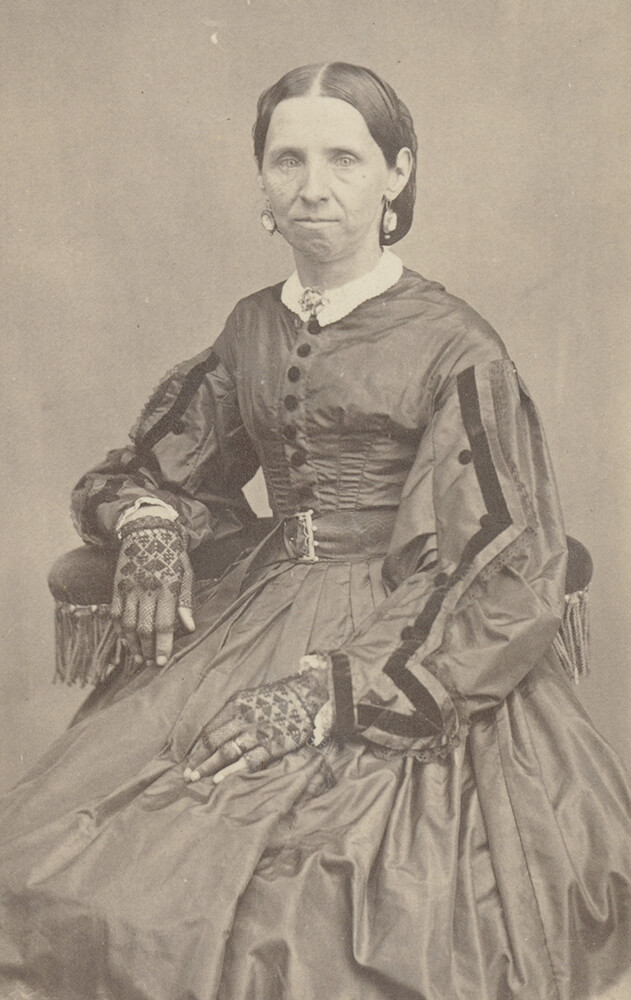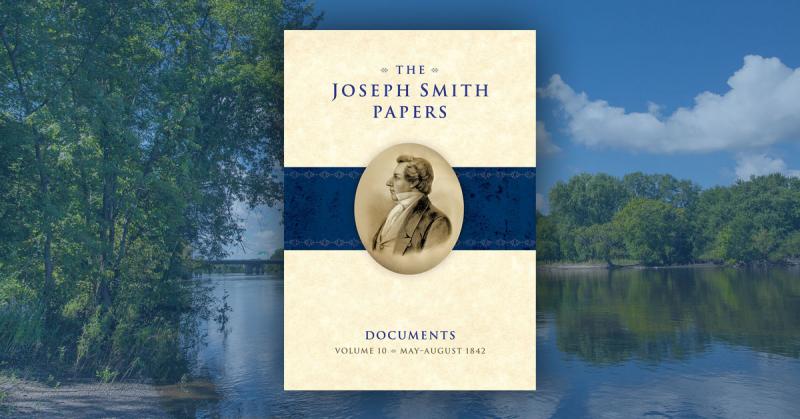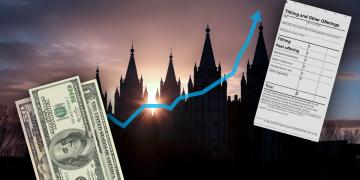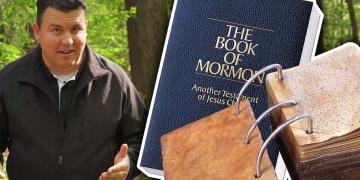You are here
Book of Mormon Central is in the process of migrating to our new Scripture Central website.
We ask for your patience during this transition. Over the coming weeks, all pages of bookofmormoncentral.org will be redirected to their corresponding page on scripturecentral.org, resulting in minimal disruption.
The Church Historian’s Press has announced the publication of a new volume in the Documents series of the Joseph Smith Papers Project. Under the editorship of historians Elizabeth A. Kuehn, Jordan T. Watkins, Matthew C. Godfrey, and Mason K. Allred, The Joseph Smith Papers, Documents, Volume 10: May–August 1842 compiles papers dating to the summer of 1842 and “covers a time during which Joseph Smith oversaw missionary work, encouraged the construction of the Nauvoo temple, served as editor of the church newspaper Times and Seasons, and struggled to help the hundreds of converts gathering to Nauvoo, Illinois.”
Documents, Volume 10 (D10) contains 105 documents, including “correspondence, editorials, reports of discourses, minutes of meetings, municipal and legal documents, military records, financial records, and notices, as well as a revelation on conducting a plural marriage sealing.”
Documents collected in D10 of the Joseph Smith Papers Project
- 60 letters to and from Joseph Smith
- 11 minutes of meetings and discourses
- 8 selections from the Times and Seasons that were published under Joseph’s editorship
- 10 municipal records
- 8 financial records
- 4 legal records
- 2 revelations
These papers demonstrate “an extraordinarily busy time” of Joseph Smith’s life, according to editor Elizabeth Kuehn. Indeed, “The demands on his time were so great that Wilford Woodruff wrote in June that he had ‘never seen Joseph as full of business as of late,’ noting that ‘he hardly gets time to sign his name.’” As explained by the editors in the volume’s introduction, the reason for this business was that “the period from May through August 1842 was one of significant change and increasing tension for Joseph Smith.”
In May, he introduced new religious rituals, directed missionary work, and struggled to organize resources to provide for the hundreds of converts from the United States and England who continued to gather to Nauvoo, Illinois. While he was engaged in these and other endeavors, two events occurred that dramatically affected his life and those of his followers over the next four months. The first was the excommunication of John C. Bennett, due to sexual misconduct, and Bennett’s departure from Nauvoo. Bennett shifted from being Smith’s supporter and ally to his vehement opponent, undertaking a campaign of slander and libel against Smith in print and in public lectures. The second defining event of these months, also occurring in May, was an assassination attempt on former Missouri governor Lilburn W. Boggs by an unknown assailant. Rumors began to circulate that the assassin had been sent by Joseph Smith, which prompted another attempt to have him extradited to Missouri for prosecution. Amid these larger concerns, Smith shouldered a staggering workload of civic and ecclesiastical responsibilities.1
The scandal surrounding John C. Bennett’s apostasy is highlighted by several of the documents in D10. On 11 May 1842, for example, notice was given by the First Presidency of their having “withdraw[n] the hand of fellowship” from Bennett in light of his misdeeds.

Sarah Ann Whitney, who was sealed to Joseph Smith as a plural wife on 27 July 1842. Photograph circa 1867 Church History Library, Salt Lake City. Photograph by Edward Martin.
Closely related to Bennett’s excommunication and his subsequent speaking tour and publications against Joseph Smith was plural marriage. “During [the summer months of 1842], Joseph Smith also expanded his involvement in the practice of plural marriage. . . . Smith and his coreligionists understood plural marriage as part of a broader restoration of such Old Testament ideas as temple worship and orders of the priesthood—all of which tied into the belief that they were living in the last dispensation of the earth’s history.”2 Some of the papers in D10 shed important light on this practice. A revelation given on 27 July 1842, for instance, “provided instructions for [Newel K.] Whitney to use in performing the sealing of his daughter Sarah Ann Whitney to [Joseph] that same day.” The revelation “promised immortality and eternal life to Sarah Ann, and by extension her entire family, through her sealing to [Joseph]. By uniting the Whitney family with [Joseph], the marriage created kinship ties that promised to seal the two families together eternally.”
Also appearing in D10 are selections of content from the Times and Seasons while Joseph was editor of the paper. During the summer of 1842,
Joseph Smith continued as editor of the church’s semimonthly newspaper, the Times and Seasons. He had purchased the printing office and newspaper from Ebenezer Robinson in February 1842. Although he was identified as editor in the 15 February 1842 issue of the paper, Smith’s editorial oversight began the following month, starting with the 1 March issue. His involvement as editor fluctuated over the next eight months; some issues of the newspaper included editorials he likely wrote, while others were produced when he was absent from Nauvoo. Apostles John Taylor and Wilford Woodruff oversaw the daily operations of the office, but until October 1842 the newspaper bore Smith’s name, which implied that he took editorial responsibility and thus endorsed all published content.3

"Traits of the Mosaic History," an editorial published in the Times and Seasons while Joseph Smith was acting editor of the paper. Image from the Joseph Smith Papers website.
Some of the editorials that appeared in print during the summer of 1842 touched on the Book of Mormon. The 15 June 1842 issue of the paper, for example, published a signed editorial arguing for “traits of Mosaic history” (such as the Flood and the confusion of the languages at the Tower of Babel) appearing in the legends of native peoples of Central America. After republishing excerpts from contemporary publications on Mexican history and anthropology, the editorial argued that “there are many things contained in the above that go to support the testimony of the Book of Mormon, as well as that of the Mosaic history.” In addition, Ether 1:35–43 was reprinted with the comment that “the tradition and hyeroglyphics of the Zaltees, the Colhuacans, and the Azteca nations . . . is so like that contained in the Book of Mormon, that the striking analogy must be seen by every superficial observer.”
In another signed editorial that appeared in print on 15 July 1842 under the title “American Antiquities,” the paper reproduced the findings of Josiah Priest’s American Antiquities and Discoveries in the West (1833), which reported the discovery of idols, jewelry, and metallic weaponry in Tennessee and Mississippi. The editorial also cited the recent discovery of large ruins in Central America by John Lloyd Stephens and Frederick Catherwood in their Incidents of Travel in Central America, Chiapas, and Yucatan (1842), a copy of which Joseph had been gifted in November 1841. “If men, in their researches into the history of this country, in noticing the mounds, fortifications, statues, architecture, implements of war, of husbandry, and ornaments of silver, brass, &c.—were to examine the Book of Mormon,” the editorial read, “their conjectures would be removed, and their opinions altered; uncertainty and doubt would be changed into certainty and facts; and they would find that those things that they are anxiously prying into were matters of history, unfolded in that book.” “Stephens and Catherwood’s researches in Central America abundantly testify of this thing,” it continued. “The stupendous ruins, the elegant sculpture, and the magnificence of the ruins of Guatamala, and other cities, corroborate this statement, and show that a great and mighty people—men of great minds, clear intellect, bright genius, and comprehensive designs inhabited this continent. Their ruins speak of their greatness; the Book of Mormon unfolds their history.” As these editorials demonstrate, Joseph Smith and other early Latter-day Saints were excited to see new discoveries seemingly vindicate the claims made in the Book of Mormon and eagerly shared this new evidence with the world.
As with the other volumes in the Documents series, D10 offers a rich variety of texts that touch on multiple aspects of Joseph Smith’s life and ministry. “The texts presented in this volume, with their detailed historical annotation, make this book a crucial resource for those seeking a deeper understanding of Joseph Smith as prophet of the Church of Jesus Christ of Latter-day Saints, as mayor of Nauvoo, as leader of the Nauvoo Legion, and as a man who, despite the constant pressure of events, continued to faithfully lead his people.”
The Joseph Smith Papers, Documents, Volume 10: May–August 1842 is now available for purchase at Deseret Book, Amazon, and other retailers. The next volume of the series, Documents, Volume 11: September 1842–February 1843, is scheduled for publication later this year.
(See additionally this report in the Church News and this one in the Deseret News.)
Additional Resources
Book Review: New Joseph Smith Papers Volume Illuminates Joseph Smith's time in Nauvoo
Where Did the Book of Mormon Happen?
Video: What did prophets think about Book of Mormon geography? Their old books may give clues.
How “Saints” and Jacob’s Teachings Can Help Contextualize Polygamy
- 1. Elizabeth A. Kuehn, Jordan T. Watkins, Matthew C. Godfrey, and Mason K. Allred, eds., The Joseph Smith Papers, Documents, Volume 10: May–August 1842 (Salt Lake City, UT: The Church Historian’s Press, 2020), ix.
- 2. Kuehn et al, eds., The Joseph Smith Papers, Documents, Volume 10, xxvi.
- 3. Kuehn et al, eds., The Joseph Smith Papers, Documents, Volume 10, xxi–xxii.
Subscribe
Get the latest updates on Book of Mormon topics and research for free








